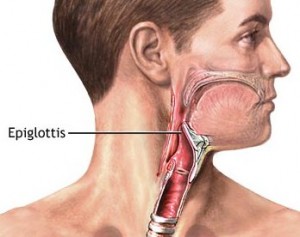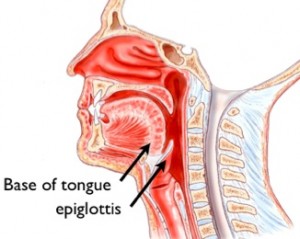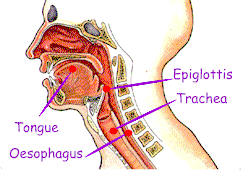Ever wondered what keeps your food from going off into your windpipes while eating? It is the humble Epiglottis that does the job for you. Read and know all what is Epiglottis, its location, its function, the diseases that affect it and the treatment of those conditions.
Epiglottis Definition
Page Contents
- 1 Epiglottis Definition
- 2 Epiglottis Location
- 3 Epiglottis Action
- 4 Epiglottis and Swallowing
- 5 Epiglottis Structure
- 6 Function of Epiglottis in the Respiratory System
- 7 How Does The Epiglottis Work?
- 8 Epiglottis and Glottis
- 9 Epiglottis Function in Digestion
- 10 Epiglottis Function in Speech
- 11 Epiglottis Problems
- 12 Epiglottis Surgery
- 13 Epiglottis Pictures

Picture 1 – Epiglottis
Source – daviddarling
Epiglottis is structure of the body that hangs down the windpipe. When food is swallowed, the Epiglottis keeps it from entering the lungs. In the absence of Epiglottis a person can choke and cough every time while eating.
Epiglottis Location
Epiglottis is found at the entrance of the larynx. It projects sideways at the rear of the tongue and the hyoid bone.
Epiglottis Pronunciation = “A-pee-glot-tis”.
Epiglottis Action
Normally, Epiglottis points upwards allowing free passage of air into the trachea and larynx. During eating and swallowing process, the Epiglottis shuts itself thus blocking the opening into the trachea. When the swallowing is done, the Epiglottis opens up again allowing normal breathing.
Epiglottis and Swallowing
The Epiglottis function in swallowing is a very important one. While swallowing food and water, it draws itself back to cover the entry point of the larynx which prevents food and drink from going into the windpipe. These edible substances enter the esophagus and directly go into the stomach. When the swallowing action ends, the epiglottis moves up once again making normal flow of air into the trachea (windpipe).
Epiglottis Structure
Epiglottis is composed of elastic cartilage. Cartilage is a tough elastic tissue. It is made of small bundles of fibers that are highly elastic. This makes it sturdy yet flexible. The cartilage tissue in the Epiglottis is coated with mucus membranes. This makes it hard enough to form a barrier before the trachea while swallowing. At the same time, it is soft enough to fold itself once the action is done.
Function of Epiglottis in the Respiratory System
The Epiglottis function in respiratory system is a very important one. It is because of this cartilaginous structure that you do not choke while eating or drinking. It is because the Epiglottis shuts the entrance to the trachea that food and drinks are transferred to the digestive system. However, sometimes food or liquid falls into pockets at either side of the Epiglottis. These can be safely coughed up and choking can be prevented. This is the reason why it is not safe to talk while swallowing.
How Does The Epiglottis Work?
Most of us have no idea how the Epiglottis works inside our body. The function of the Epiglottis is highly interesting and important. As aforementioned, it is placed behind the hyoid bone in the neck. During swallowing, the neck muscles lift the hyoid bone which causes the Epiglottis to fold down and obstruct the airway thus diverting the swallowed substances to the esophagus.
Epiglottis and Glottis
Many people tend to mistake the Epiglottis with the glottis. Both are structurally and functionally different parts of the anatomy. The epiglottis is the cartilage flap fixed to the entrance of the larynx. Glottis is the space lying between the vocal folds and arytenoid cartilages located in the larynx. In other words, it is an opening to the larynx. It is known as the organ of speech or the vocal equipment of the larynx. It is the Glottis where voice tone is produced.
Epiglottis Function in Digestion
Epiglottis automatically delivers food and nutrients to the digestive system. It is because of this organ that swallowed particles are diverted to the esophagus and not the respiratory system. While swallowing, the organ flops down to channelize the eaten particles directly to the stomach.
Epiglottis Function in Speech
The Epiglottis has a vital role in speech. It acts as an articulator in the production of vowels and pharyngeal consonants. In pharyngeals, Epiglottis articulates against the posterior pharynx wall. During slow speech, the speech is generated through a narrow opening.
While pronouncing vowels, the opening between the Epiglottis and the pharynx becomes larger. In case of pronunciation of consonants, the aperture becomes smaller. Epiglottis is also involved in whisper, though it is seen to be more retracted than in normal speech.
Epiglottis Problems
Like any other organ in the body, the Epiglottis can be affected by a number of conditions. Some of the main Epiglottis diseases are
Epiglottitis
This condition leads to the swelling of the Epiglottis. This inflammation is caused mainly by an infection due to Haemophilus influenza bacteria. However, it may also result from attack by other types of bacteria and viruses that can cause Upper Respiratory Infection.
Epiglottitis bacterial infection is now a rare disease but was once one of the very common Epiglottis problems in children in the age group 2 to 6. Today, it is rarely seen to affect adults. But it is a life-threatening disorder and can even lead to death due to breathing difficulties that it causes.
Epiglottis Ulcers
Ulcers in Epiglottis are highly discomforting. They can give rise to extremely uncomfortable symptoms like sore throat and blocked ears. The presence of ulcers in Epiglottis makes it very difficult to swallow food and water. The throat can pain even while swallowing your own saliva. Chlorhexadine, Phylorinol, Tetracycline and codeine can be effective in curing Epiglottis lesions.
Epiglottis Surgery
Some people inhale food particles into their lungs from the mouth. This problem is known as Chronic Aspiration and can cause frequent respiratory infections, coughs and sore throat. In such cases, the Epiglottis needs to be surgically modified. However, the aim of surgery is to only change the structure of the Epiglottis and not remove it altogether. Complete Epiglottis removal can cause serious problems. The air breathed in would enter the stomach and the food would travel to the trachea. Epiglottis repair surgery intends to put an end to Chronic Aspiration without removing this vital organ.
Epiglottis Pictures
Want to check how the Epiglottis actually looks like? Here are some useful Epiglottis photos for you. Take a look at these Epiglottis diagrams and know about the appearance of this important anatomical organ.

Picture 2 – Epiglottis Image
Source – centerforsoundsleep
Picture 3 – Epiglottis Photo
Source – mycotopia
Epiglottis is a very important part of our body. It is this organ that aids in speech and eating foods and drinks. It is also because of this body organ that proper respiration becomes possible for us.
References:
http://en.wikipedia.org/wiki/Epiglottis
http://www.wisegeek.com/what-is-an-epiglottis.htm
http://www.ehow.com/about_4606521_function-epiglottis_.html
http://www.nlm.nih.gov/medlineplus/ency/article/000605.htm
http://kidshealth.org/kid/word/e/word_epiglottis.html
http://www.buzzle.com/articles/epiglottis-function.html
http://www.women-health-guide.com/child-diseases/epiglottitis.htm


QUESTION: I sing in a choir and one day I was singing bass and I force my voice to much to low, and I felt that my epiglottis started to vibrate and I couldn’t sing any more that night. After awhile I was able to sing again both I can not reach the high notes like I used to do. Is that something that can be fix? please let me know Thank you
Hi, after a throat operation, i found that the epiglottis in my throat would move upward when i open up my mouth.May i know why? Worrying…..
This is very helpfull to me. Thanks allot
Very very helpful….. Thanks a lot….